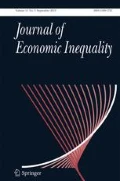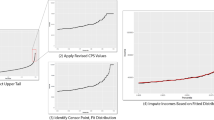Abstract
We measure inequality of opportunity for earnings acquisition in the U.S. between 1968 and 2001. Following recent theories of social justice, earnings determinants are divided into two parts: Circumstances, which are characteristics outside individual control and effort representing factors impacting earnings but under individuals’ responsibility. Equality of opportunity requires that inequality of circumstances must be corrected while differences of effort must remain unaltered. Circumstances are represented by parental education and occupation, ethnic origin, place of birth and age. Effort is modeled with schooling choices and labour supply decisions. Using the PSID from 1968 to 2001, we provide two alternative assessments of inequality of opportunity using counterfactual distributions. The statistical framework is semi-parametric and builds on duration models. Finally, we conclude that inequality of opportunity represents between 20 and 43% of earnings inequality, but decreases all over the period reaching around 18% in 2001.
Similar content being viewed by others
References
Alesina, A., Glaeser, E.: Fighting Poverty in the US and Europe: A World of Difference. Oxford University Press, London (2006)
Alesina, A., La Ferrara, E.: Preferences of redistribution in the land of opportunities. J. Public Econ. 89(5–6), 897–931 (2005)
Arneson, R.: Equality and equal opportunity for welfare. Philos. Stud. 56, 77–93 (1989)
Atkinson, A.B.: On the measurement of inequality. J. Econ. Theory 18, 59–80 (1970)
Autor, D.H., Katz, L.F., Kearney, M.S.: Trends in U.S. wage inequality: re-assessing the revisionists. Rev. Econ. Stat. 90(2), 300–323 (2008)
Betts, J., Roemer, J.: Equalizing opportunity for racial and socioeconomic groups in the United States through educational finance reform. In: Woessmann, L., Peterson, P. (eds.) Schools and the Equal Opportunity Problem. MIT, Cambridge (2006)
Bourguignon, F., Ferreira, F.H., Lustig, N. (eds.): The Microeconomics of Income Distribution Dynamics, 436 pp. World Bank, Oxford University Press, Washington, DC (2005)
Bourguignon, F., Ferreira, F.H., Menendez, M.: Inequality of opportunity in Brasil. Rev. Income Wealth 53(4), 585–618 (2007)
Buchinsky, M.: Changes in the U.S. wage structure 1963–1987: application of quantile regression. Econometrica 62(2), 405–458 (1994)
Cameron, S., Taber, C.: Estimation of educational borrowing constraints using returns to schooling. J. Polit. Econ. 112(1), 132–182 (2004)
Carneiro, P., Heckman, J.: The evidence on credit contraints in post-secondary schooling. Econ. J. 112, 989–1018 (2002)
Checchi, D., Peragine, V.: Regional disparities and inequality of opportunity: the case of Italy. IZA Discussion Paper No. 1874 (2005)
Dardanoni, V., Fields, G.S., Roemer, J., Sanchez-Puerta, M.L.: How demanding should equality of opportunity be, and how much have we achieved? In: Morgan, S., Grusky, D., Fields, G. (eds.) Mobility and Inequality: Frontiers of Reasearch in Sociology and Economics. Stanford University Press, Stanford (2005)
Davidson, R., Duclos, J.-Y.: Statistical inference for stochastic dominance and for the measurement of poverty and inequality. Econometrica 68(6), 1435–1464 (2000)
Dinardo, J., Fortin, N., Lemieux, T.: Labor market institutions and the distribution of wages, 1973–1992: a semi-parametric approach. Econometrica 64, 1001–1044 (1996)
Donald, S.G., Green, D.A., Paarsch, H.J.: Differences in wage distributions between Canada and the United States: an application of a flexible estimator of distribution functions in the presence of covariates. Rev. Econ. Stud. 67(4), 609–633 (2000)
Dworkin, R.: What is equality. part 1: equality of welfare. Philos. Public Aff. 10, 185–246 (1981)
Eckstein, Z., Nagypal, E.: The evolution of U.S. earnings inequality. Fed. Reserve Bank Minneap. Q. Rev. 28(2), 10–29 (2004)
Gottschalk, P., Danziger, S.: Inequality of wage rates, earnings and family income in the United-States, 1975–2002. Rev. Income Wealth 51(2), 231–254 (2005)
Gottschalk, P., Joyce, M.: Cross-national differences in the rise in earnings inequality: market and institutional factors. Rev. Econ. Stat. 80(4), 489–502 (1998)
Gottschalk, P., Smeeding, T.M.: Cross-national comparisons of earnings and income inequality. J. Econ. Lit. 35, 663–687 (1997)
Jenkins, S.: Accounting for inequality trends: decomposition analyses for the U.K., 1971–86. Economica 62(1), 29–63 (1995)
Juhn, C., Murphy, K.M., Pierce, B.: Wage inequality and the rise in return to skill. J. Polit. Econ. 101, 410–442 (1993)
Katz, L.F., Autor, D.H.: Changes in the wage structure and earnings inequality. In: Ashenfelter, O., Card, D. (eds.) Handbook of Labor Economics, vol. 3A. Elsevier Science, Amsterdam (1999)
Katz, L.F., Murphy, K.M.: Changes in relative wages, 1963–1987: supply and demand factors. Q. J. Econ. 107, 35–78 (1992)
Lefranc, A., Pistolesi, N., Trannoy, A.: Inequalities of outcome vs inequalities of opportunities: are all western societies alike? Rev. Income Wealth (2005, forthcoming)
Lemieux, T.: Increasing residual wage inequality: composition effects, noisy data, or rising demand for skills? Am. Econ. Rev. 96, 461–498 (2006)
Levy, F., Murnane, R.J.: U.S. earnings levels and earnings inequality: a review of recent trends and proposed explanations. J. Econ. Lit. 30, 1333–1381 (1992)
Mata, J., Machado, J.A.: Couterfactual decomposition of changes in wage distributions using quantile regression. J. Appl. Econ. 20(4), 445–465 (2005)
Meyer, B.D.: Unemployment insurance and unemployment spells. Econometrica 58(4), 757–782 (1990)
Neal, D.: Why has black-white skill convergence stopped? In: Hanushek, E., Welsh, F. (eds.) Handbook of the Economics of Education. Elsevier Science, Amsterdam (2006)
O’Neill, D., Sweetman, O., Van de Gaer, D.: The effect of measurement error and omitted variables when using transition matrices to measure intergenerational mobility. J. Econ. Inequal. 5(2), 159–178 (2007)
Roemer, J.: A pragmatic theory of responsibility for the egalitarian planner. Philos. Public Aff. 22(2), 146–166 (1993)
Roemer, J.: Equality of Opportunity. Harvard University Press, Cambridge (1998)
Van De Gaer, D.: Equality of Opportunity and Investment in Human Capital. Ph.D. thesis, K.U. Leuven (1993)
Author information
Authors and Affiliations
Corresponding author
Rights and permissions
About this article
Cite this article
Pistolesi, N. Inequality of opportunity in the land of opportunities, 1968–2001. J Econ Inequal 7, 411–433 (2009). https://doi.org/10.1007/s10888-008-9099-7
Received:
Accepted:
Published:
Issue Date:
DOI: https://doi.org/10.1007/s10888-008-9099-7




